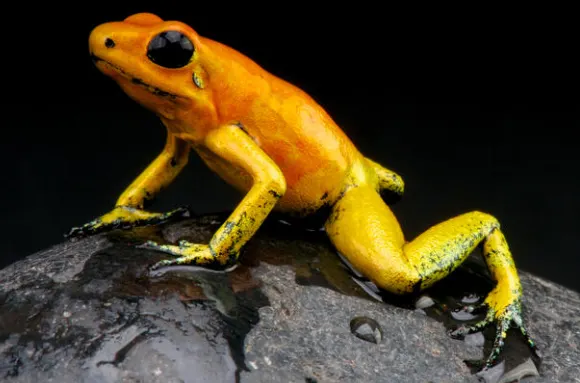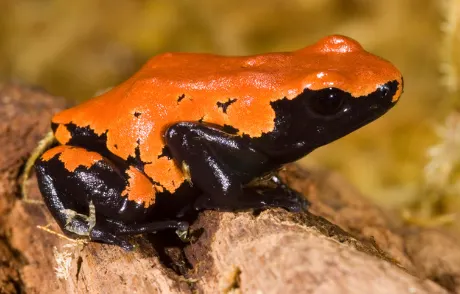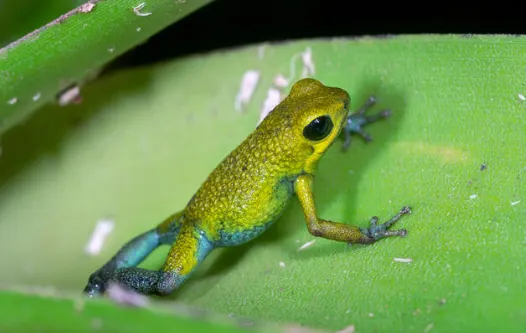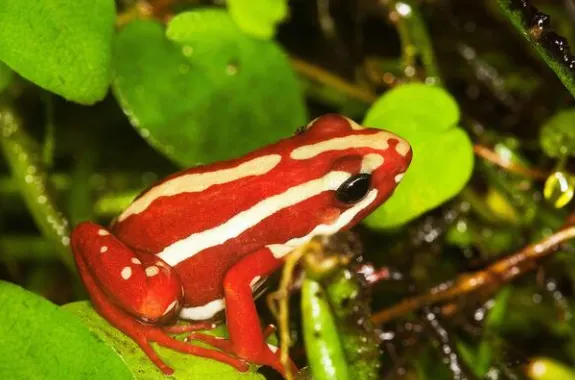Imagine the allure of a dense tropical rainforest: lush foliage, vibrant wildlife, and the symphony of nature’s chorus. Yet, concealed within this verdant realm lurks a silent danger: deadly frogs. These diminutive creatures, often heard but rarely seen, possess a lethal secret—poison. Join us as we unravel the mysteries of the five most deadly frogs in the world.
Table of Contents
The Habitat of Deadly Frogs
The deadliest frogs on the planet hail from the verdant landscapes of Central and South America. These regions provide the ideal habitat for these toxic amphibians, with their humid climates and abundant rainfall nurturing the lush rainforests they call home.
These frogs, with their porous skin, rely on moisture to maintain their slimy texture, making the rainforest environment essential for their survival.
Meet the Five Most Deadly Frogs:
1. The Golden Poison Dart Frog

Known as the deadliest frog globally, the golden poison dart frog inhabits the Pacific Coast of Colombia. Initially adorned with vibrant hues of green, yellow, or orange, these frogs mature into a dark-colored adult form. Their alkaloid-laden skin secretes a potent poison, causing muscle paralysis—a lethal defense mechanism. These frogs were historically utilized by indigenous tribes for their poison, enhancing the effectiveness of their hunting weapons.
2. The Dyeing Poison Frogs

Residing in Venezuela and Brazil, the dyeing poison frog owes its name to indigenous tribesmen who used its vibrant skin secretions to dye parrot feathers. Its toxic skin, a blend of yellow and dark blue, induces swelling and paralysis upon contact, serving as a potent deterrent against predators. Despite their small size, these frogs wield considerable power, deterring predators and ensuring their survival in the dense rainforest ecosystem.
3. The Splashback Poison Frog

Found in the northern and northeastern regions of Brazil, the splashback poison frog captivates with its metallic hues and distinctive splash-like pattern. Infected individuals experience muscle weakness, drooling, and respiratory issues, underscoring the potency of its poison. These frogs play a vital role in maintaining the ecological balance of their habitat, their toxic presence deterring predators and contributing to the overall biodiversity of the rainforest.
4. The Granular Poison Frog

Inhabiting Costa Rica and Panama, the granular poison frog boasts a vivid orange hue with blue and green accents. Despite its endangered status, this frog poses a significant threat to humans, with its toxic skin causing paralysis upon contact. The granular poison frog serves as a poignant reminder of the fragility of rainforest ecosystems, its survival intricately linked to the preservation of its habitat.
5 The Phantasmal Poison Frog

Residing in Ecuador, the phantasmal poison frog sports a striking red hue with longitudinal white stripes. Victims of its potent toxin, epibatidine, face paralysis and even death. Habitat loss and illegal pet trade further imperil this endangered species. Despite their perilous reputation, these frogs are integral to the delicate balance of the rainforest, their presence indicative of the richness and complexity of their environment.
Precautions in the Presence of Deadly Frogs
While these frogs may enchant with their vibrant colors, their toxicity demands caution. Adventurers venturing into their domain must exercise vigilance, as these deadly frogs may lurk on the forest floor or amidst the canopy. Guided tours offer a safe means of exploration, ensuring an unforgettable yet secure rainforest experience.
Amidst the lush rainforests, nature holds both wonders and risks in the form of deadly frogs. By approaching with knowledge and caution, we explore the mysteries of these creatures while prioritizing our safety. So, let’s tread carefully and appreciate the rainforest’s allure, mindful of its toxic inhabitants.
- Enchi Ball Python: A Unique and Stunning Morph of Python regius - March 27, 2025
- Emerald Tree Monitor: The Enigmatic Green Guardian of the Rainforest - March 26, 2025
- The Egyptian Cobra (Naja haje): A Fascinating Serpent - March 25, 2025
